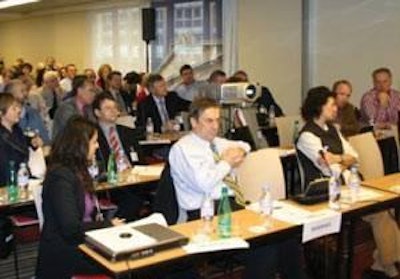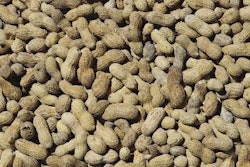
According to the present regulation of food and feed safety in Europe, the assessment of new additives is split between risk assessment and risk management. Generally spoken, the first part involves the identification of which risks are related to the use of an additive for a certain application and the second part is an evaluation on any risks present. The European Food and Safety Association (EFSA) is responsible for the risk assessments. In agreement with the general food law (2002), EFSA was established five years ago. It is the vision of the executive director of EFSA, Mrs.. Catherine Geslain Lanéelle, that EFSA is globally recognized as the European reference body for risk assessment on feed and feed safety, animal health and welfare, nutrition, plant protection and plant health.
Following the fifth anniversary of its existence, EFSA has organised a conference with stakeholders of the feed additive industry on 24-25 October to present and discuss the subject of risk assessment of feed additives in the European Union (EU). This is very timely because new guidelines on the assessment are expected soon. Main stakeholders were invited to participate in the conference, including representatives from the industry, authorities from countries and consultants for feed additives. Also, several noteworthy people from EFSA and the EU authorities were represented, giving introductions on the risk assessment and the risk management of feed additives, in light of the regulations on feed additives and of the present and future guidelines on the assessment.
Panels focus on specific issues
EFSA is split up in several panels, dealing with different issues. Each panel consists of experts from different countries and having different areas of expertise. Together a panel covers all areas of expertise, which is necessary to make full risk assessments. At the moment there are nine panels, which together cover the whole food chain. The panel covering/responsible for feed additives is called FEEDAP and is supported by a professional secretariat in Parma, Italy. Head of the Feedap Unit is Mrs.. Claudia Roncancio Peña.
The group within the European authority dealing with feed additives is the Standing Committee. The Standing Committee consists of representatives of all the different EU countries. After Feedap has made a risk assessment on a product, the Standing Committee evaluates the risk management and proposes a regulation for approval or turns down the application.
In general, EFSA gets their tasks from the Standing Committee, but in some cases it can also be possible that EFSA sets its own tasks. Depending on the task set, panels may work together and they may be supported by external experts. In recent years, EFSA received 250-300 questions yearly. The experts within the different panels should be unbiased and originate from different universities and institutes. The aim of EFSA is to be transparent in their decisions, which should be based on harmonized approaches.
Focusing on safety
The risk assessment EFSA is making is focused on the safety for the animal that consumes the additive, the worker who works with the additive and the consumer who uses the animal products as well as the efficacy of the product. The Feedap unit consists of 21 members of different scientific background, invites experts on an ad hoc basis when needed and is supported by staff. The members of the panels are appointed by the management board for a period of three years (renewable). Panel members are selected from among those interested based on personal expertise that fills the need of the panel. In their work, Feedap cooperates with other groups, such as the European Medicines Agency, member states, European commission, Community Reference laboratory, chief veterinary officers and also the USA-based Food and Drug Administration.
Continuing areas of work
Ongoing tasks which Feedap is working on are the assessment of herbs, essential oils, and plant products as additives; functional groups for zootechnical additives and compatibility of microorganisms with (veterinary) antimicrobials (open for consultancy).
In the period of 2003 2007, under regulation 1831 of 2003, there were 82 requests for applications of feed additives. Up to now, 44 have been adopted, as shown in Table 1.
When working on tasks, working groups are put together that focus on special tasks or questions and are often related to the categories mentioned above. The people who join the working group are selected on the required areas of specialty.
The principle of the procedure for approval of a feed additive is that the applicant sends a dossier to EFSA. It is expected that within a few months, new guidelines will be approved, which will describe the information that has to be provided in an application dossier. A risk assessment by EFSA, according to the procedures, takes six months. However, whenever EFSA needs additional information, they put a list of questions to the applicant and then the "clock" stands still until there the answers are provided. Within the time limit of six months (plus time related to the questions), EFSA will provide an opinion to the European Commission.
In addition to such a dossier, the applicant needs to send samples to the "Joint Research Centre" (JRC). They evaluate the method of analysis of the feed additive, test it and validate if necessary. JRC also stores samples of the feed additive.
After EFSA has sent their opinion to the EU, they have a three-month period for the risk management. Also in this period, it is possible that questions are asked to the applicant and that the clock is at stand still. After the vote for the approval is positive, it will take three months before the approval is effective because of bureaucratic activities such as translation in all the different EU languages.
In 2003, with the new regulation in place, it was decided that new guidelines needed to be set up for the assessment of feed additives. Until now, there are several regulations and guidelines that influence the requirements for an assessment. The new guidelines will provide procedures for all additives and according to Prof. Jürgen Gropp, they will have a higher consistency, be more transparent, have a higher predictability and be more flexible.
Bovines (dairy and meat animals, including calves), sheep (meat animals), pigs, chicken, turkeys and fish (Salmonidae) are defined as "major species." But the guidelines are also applicable to petfood and all other species, the latter being called "minor species." Depending on the type of additive and the species for which it is to be applied for, more or less information needs to be provided. If additives are already approved for food use, normally less information needs to be supplied.
In principle a dossier consists of three parts. One part concerns information on the identity of the additive, the second part the safety (for the animals, workers and the consumer), the third part the efficacy (proof of the claim). Also, possible effect on the environment needs to be evaluated.
Silage additives regulated
At the stakeholders conference, Dr Andrew Chesson, chairman of Feedap, discussed the requirements for silage additives. Because silage additives also end up in the animal, silage additives are also regarded as feed additives and registration is required. When the additive is already approved as a feed additive for a given species and the intake of the animal is similar, the requirements for a dossier will be much lower.
Also at the conference, Dr. Pier Sandro Cocconcelli, Feedap member, noted that EFSA is evaluating a number of micro-organisms that they may consider as safe: "Qualified Presumption of Safety." There is no final decision on the subject, but when it is accepted, the micro-organisms on that list will not need a safety assessment.
Regarding communication, Mrs.. Karen Talbot, EFSA, pointed out that the core values of EFSA are: scientific excellence, independence, openness, transparency and responsiveness. EFSA has to communicate with the public at large, all stakeholders and the EU (and national) authorities, based on EFSA's risk assessments and scientific expertise. It should be considered that experts and the public have different attitudes towards risk approaches, as shown by examples in Table 2.
Among those in attendance representing industry was Mr.. Didier Jans of Fefana, Federation of Feed Additive Manufacturers. He stated that Fefana has set up documents that serve as a guide and help in setting up dossiers. He states, however, that the documents should be seen as an addition to the guidelines and they are not meant as replacement.
Also represented was Fefac, the European Feed Manufacturers Federation which has member associations in most of the member states. Fefac was represented by Mr. Arnoud Bouxin who indicated that additives remain important for the feed industry. He appreciated the quality of EFSA and the assessment on feed additives, but mentioned that care should be taken that the procedures should not be too long, as it would slow down developments and it would negatively influence the competitiveness with the feed industry outside the EU.

















